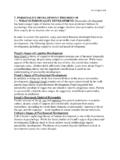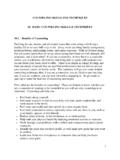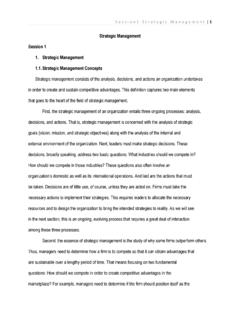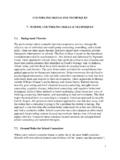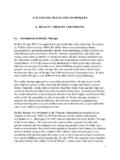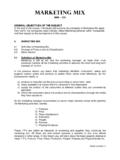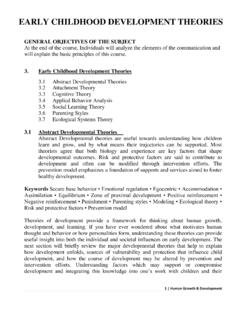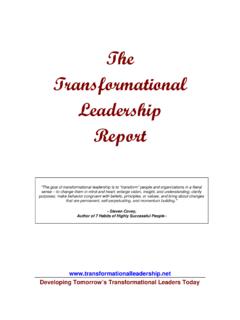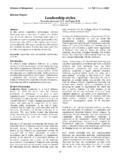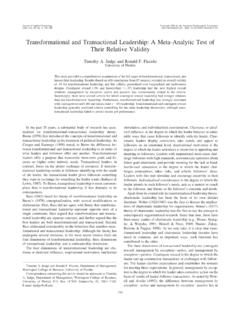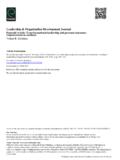Transcription of 10. Task Oriented Leadership - Programs, Courses AIU ...
1 1 | P a g e 10. Task Oriented Leadership Task- Oriented (or task-focused) Leadership is a behavioral approach in which the leader focuses on the tasks that need to be performed in order to meet certain goals, or to achieve a certain performance standard. Relationship- Oriented (or relationship-focused) Leadership is a behavioral approach in which the leader focuses on the satisfaction, motivation and the general well-being of the team members. Task- Oriented and relationship- Oriented Leadership are two models that are often compared, as they are known to produce varying outcomes under different circumstances. Qualities of task- Oriented Leadership Task- Oriented leaders focus on getting the necessary task, or series of tasks , at hand in order to achieve a goal.
2 These leaders are typically less concerned with the idea of catering to employees, and more concerned with finding the step-by-step solution required to meet specific goals. They will often actively define the work and the roles required, put structures in place, and plan, organize, and monitor progress within the team. The advantages of task- Oriented Leadership is that it ensures that deadlines are met and jobs are completed, and it's especially useful for team members who don't manage their time well. Additionally, these types of leaders will tend to exemplify strong understanding of how to get the job done by focusing on the necessary workplace procedures, thus can delegate work accordingly in order to ensure that everything gets done in a timely and productive manner.
3 However, because task- Oriented leaders don't tend to think much about their team's well-being, this approach can suffer many of the flaws of autocratic Leadership , including causing motivation and retention problems. Qualities of relationship- Oriented Leadership Relationship- Oriented leaders are focused on supporting, motivating and developing the people on their teams and the relationships within. This style of Leadership encourages good teamwork and collaboration, through fostering positive 2 | P a g e relationships and good communication. Relationship- Oriented leaders prioritize the welfare of everyone in the group, and will place time and effort in meeting the individual needs of everyone involved. This may involve offering incentives like bonuses, providing mediation to deal with workplace or classroom conflicts, having more casual interactions with team members to learn about their strengths and weaknesses, creating a non-competitive and transparent work environment, or just leading in a personable or encouraging manner.
4 The benefits of relationship- Oriented Leadership is that team members are in a setting where the leader cares about their well-being. Relationship- Oriented leaders understand that building positive productivity requires a positive environment where individuals feel driven. Personal conflicts, dissatisfaction with a job, resentment and even boredom can severely drive down productivity, so the these types of leaders put people first to ensure that such problems stay at a minimum. Additionally, team members may be more willing to take risks, because they know that the leader will provide the support if needed. The downside of relationship- Oriented Leadership is that, if taken too far, the development of team chemistry may detract from the actual tasks and goals at hand.
5 The term people- Oriented is used synonymously, whilst in a business setting, this approach may also be referred to as employee- Oriented . Core Leadership theories Why are some leaders successful, while others fail? The truth is that there is no "magic combination" of characteristics that makes a leader successful, and different characteristics matter in different circumstances. This doesn't mean, however, that you can't learn to be an effective leader. You just need to understand the various approaches to Leadership , so that you can use the right approach for your own situation. One way of doing this is to learn about the core Leadership theories that provide the backbone of our current understanding of Leadership .
6 Since the early 20th century, four main groups of theories have emerged. We look at these core Leadership theories in this article. 3 | P a g e The Four Core Theory Groups Let's look at each of the four core groups of theory, and explore some of the tools and models that apply with each. (Keep in mind that there are many other theories out there.) 1. Trait Theories What Type of Person Makes a Good Leader? Trait theories argue that effective leaders share a number of common personality characteristics, or "traits." Early trait theories said that Leadership is an innate, instinctive quality that you do or don't have. Thankfully, we've moved on from this idea, and we're learning more about what we can do to develop Leadership qualities within ourselves and others. Trait theories help us identify traits and qualities (for example, integrity, empathy, assertiveness, good decision-making skills, and likability) that are helpful when leading others.
7 However, none of these traits, nor any specific combination of them, will guarantee success as a leader. Traits are external behaviors that emerge from the things going on within our minds and it's these internal beliefs and processes that are important for effective Leadership . 2. Behavioral Theories What Does a Good Leader Do? Behavioral theories focus on how leaders behave. For instance, do leaders dictate what needs to be done and expect cooperation? Or do they involve their teams in decision-making to encourage acceptance and support? In the 1930s, Kurt Lewin developed a framework based on a leader's behavior. He argued that there are three types of leaders: Autocratic leaders make decisions without consulting their teams. This style of Leadership is considered appropriate when decisions need to be made quickly, when there's no need for input, and when team agreement isn't necessary for a successful outcome.
8 Democratic leaders allow the team to provide input before making a decision, although the degree of input can vary from leader to leader. This style is important when team agreement matters, but it can be difficult to manage when there are lots of different perspectives and ideas. Laissez-faire leaders don't interfere; they allow people within the team to make many of the decisions. This works well when the team is highly capable, is motivated, and doesn't need close supervision. However, this behavior can arise because the leader is lazy or distracted; and this is where this style of Leadership can fail. Clearly, how leaders behave affects their performance. Researchers have realized, though, that many of these Leadership behaviors are appropriate at different times. The best leaders are those who can use many different behavioral styles, and choose the right style for each situation.
9 4 | P a g e 3. Contingency Theories How Does the Situation Influence Good Leadership ? The realization that there is no one correct type of leader led to theories that the best Leadership style depends on the situation. These theories try to predict which style is best in which circumstance. For instance, when you need to make quick decisions, which style is best? When you need the full support of your team, is there a more effective way to lead? Should a leader be more people- Oriented or task- Oriented ? These are all questions that contingency Leadership theories try to address. 4. Power and Influence Theories What is the Source of the Leader's Power? Power and influence theories of Leadership take an entirely different approach these are based on the different ways that leaders use power and influence to get things done, and they look at the Leadership styles that emerge as a result.
10 Perhaps the best-known of these theories is French and Raven's Five Forms of Power . This model highlights three types of positional power legitimate, reward, and coercive and two sources of personal power expert and referent (your personal appeal and charm). The model suggests that using personal power is the better alternative, and that you should work on building expert power (the power that comes with being a real expert in the job) because this is the most legitimate source of personal power. Another Leadership style that uses power and influence is transactional Leadership . This approach assumes that people do things for reward and for no other reason. Therefore, it focuses on designing tasks and reward structures. While this may not be the most appealing Leadership strategy in terms of building relationships and developing a highly motivating work environment, it often works, and leaders in most organizations use it on a daily basis to get things done.
